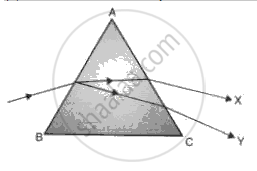Advertisements
Advertisements
Question
The diagram alongside shows the refraction of a ray of light from air to a liquid.
- Write the values of (i) angle of incidence, (ii) angle of refraction.
- Use Snell’s law to find the refractive index of liquid with respect to air.

Solution
(a) (i) Angle of incidence is the angle which the incident ray makes with normal.
∠i = 90° - 30° = 60°
(ii) The angle that the refracted beam creates with the normal is known as the angle of refraction.
∠r = 90° - 45° = 45°
(b) liquid's refractive index in relation to air.
μ Liquid = `sin i/sin r`
= `(sin 60°)/(sin 45°)`
= `(sqrt3/2)/(1/sqrt2)`
= `sqrt3/2 xx sqrt2`
= `(sqrt3 xx sqrt2)/(sqrt2 xx sqrt2)`
= `sqrt(3/2)`
APPEARS IN
RELATED QUESTIONS
What is a spectrum?
Explain the term absolute refractive index of a medium and write an expression to relate it with the speed of light in vacuum.
State the dependence of angle of deviation On the wavelength of light
How can you bend light away from the normal?
A monochromatic ray of light passes from air to glass. The wavelength of light in air is λ, the speed of light in air is c and in glass is V. If the absolute refractive index of glass is 1.5, write down
- the relationship between c and V,
- the wavelength of light in glass.
An object is viewed through a glass prism with its vertex pointing upwards. It appears to be displaced upward. Explain the reason.
Fig. shows a ray of white light that passes through a prism and produces a spectrum.
(a) Name the phenomenon that is taking place.
(b) What colour would you see at X and Y?
(c) What radiation would you detect above X and below Y?

Draw ray of light bending towards the normal while passing from glass to water. Label your diagrams.
